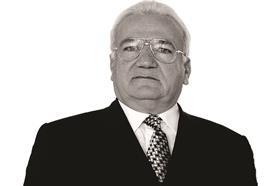A look back at the reshuffles of Balfour Beatty, Davis Langdon and in government; plus the major collapses and acquisitions of the year
TEAM GB RESTRUCTURE
As pressures, both economic and political, mounted this year, senior teams in government and industry were given a shake-up, with mixed results.
September saw the biggest ministerial reshuffle since the coalition came to power in 2010. Michael Fallon (pictured below) replaced Mark Prisk as construction minister, who moved across to the communities department to replace Grant Shapps as housing minister. Planning minister Greg Clarke became financial secretary to the Treasury (although he kept his cities brief) and was replaced by free marketeer Nick Boles. The reshuffle also saw the arrival of climate change sceptic John Hayes at the Department of Energy and Climate Change, prompting a flurry of stories about the future of wind farm policy.
The autumn brought a major restructuring at contractor Balfour Beatty, with six operating companies reduced to just one and eight existing brands culled. Chief executive Mike Peasland told Building that the restructuring would involve a cut in regional offices from 75 to 37 and would bring £30m in annual cost savings for the company, involving a maximum of 650 job losses. A further phase of restructuring was announced in November, involving the firm withdrawing from some markets, including social housing.
The growth of Dutch giant Arcadis continued in 2012, with the acquisition of the £79m-turnover, Asia-based Davis Langdon & Seah in April, following hot on the heels of its November 2011 purchase of UK firm EC Harris. This autumn EC Harris chief executive Philip Youell revealed that the firm is on target to achieve 6-7% growth in the current financial year, fuelled by the Arcadis takeover. The combined purchase of EC Harris and Davis Langdon & Seah led to a growth of year-on-year revenue of 34% for Arcadis, the company reported in November.

Consultant Davis Langdon, which was acquired by US firm Aecom in 2010, made a series of redundancies this year, with the latest cull at the end of November seeing 19 directors and 40 other staff lose their jobs. A string of senior figures also left the firm in the second half of 2012, with former head of sports and venues Alan Wilby heading to Mace, former partner Rob Knight going to Gardiner & Theobold and former head of commercial Paul Allen leaving for a career break. In August this year, Davis Langdon expanded its Asian business through the acquisition of consultancy KPK, bringing its workforce in the region to 8,000. November 2012 also saw Aecom report a £36.9m loss for the year to September 2012 following a £200m write-down on the value of its European and management support services businesses.
There was also a huge change at the top of contractor Morgan Sindall this year, with executive chairman John Morgan stepping back into the day-to-day running of the company after the departure of chief executive Paul Smith. The move followed the news of a significant restructuring of the business, involving the closure of four regional offices in the south of England and the closure of its only north-east office.

The merger of WSP and Genivar saw the creation of an engineering-led consultancy - to be known as WSP Genivar - with revenues of £1.1bn and 14,500 employees.
The new firm is listed on the Canadian stock exchange, with WSP’s listing in London cancelled in August.
In one of this year’s biggest “people” stories, it was announced at the beginning of this month that Ray O’Rourke will step down from his role as chief executive of Laing O’Rourke, the UK’s largest private contractor. He will be replaced by Anna Stewart, currently chief financial and commercial officer, from April 2013. O’Rourke said that he would continue in the role of executive chairman.
TEAM COLLAPSE
Inevitably given the state of the economy, 2012 saw some major firms go to the wall. The contrast between the performance of Team GB and UK Plc couldn’t be clearer.
In April came the collapse of the 150-year-old contractor Killby & Gayford, famous for work on prodigious projects like Number 10 Downing Street. In June, administrator BDO reported that the company’s creditors, which included Laing O’Rourke subsidiary Crown House, Travis Perkins and Construction Skills, were likely to be left £34m out of pocket.
June saw the collapse of the Doyle Group, which included specialist contractor John Doyle Construction and fit-out business Ibex Interiors. Administrator Deloitte said the company owed £47.7m across the group to unsecured creditors, with £14.7m owed by Doyle Plc, £9.4m owed by John Doyle Construction and £11.3m owed by Ibex Interiors. Deloitte said that a further £23.6m was owed to secured creditors, including the Bank of Scotland.
July brought the collapse of M&E contractor Airedale. The £66m-turnover Leeds-based firm, which was established in 1984, had completed the heating, ventilation and electrics for the London Olympic handball arena. However, administrator KPMG said the company had “experienced a difficult trading environment” in the previous 18 months and that selling the business wasn’t feasible. The company collapsed with the loss of 135 jobs.

The Northern Ireland, Scotland and Northern divisions of M&E firm Rotary also fell into administration in August. The company had been under threat since its Australian parent company Hastie - which bought the firm for £100m four years ago - collapsed in May. The company worked on Salford’s Media City development and was bidding to work on the refurbishment of the Palace of Westminster in London.
The year also brought turmoil for architecture firm RMJM. The firm’s three UK subsidiaries ceased trading in October this year after the parent company placed them in receivership. All contracts and UK-based architecture teams were acquired by a new business - RMJM European Division - which, along with RMJM Middle East, RMJM US and RMJM Asia, will now comprise the RMJM Group.
In the last 12 months two well-know consultants have been bought out of administration. In March, Capita Symonds acquired construction consultant Northcroft, which subsequently joined Capita Symonds’ management division, creating one of the UK’s largest project delivery consultancies. The news was followed in June by the Middle East-based Dar Group’s acquisition of consultants Currie & Brown.
CROWNING GLORY AND GOLDEN RASPBERRY


This year held mixed fortunes for two of London’s best-known projects. While the Shard at London Bridge celebrated its completion with a dazzling light show in July, the City’s Pinnacle tower, dubbed “the stump” due to the seven-storey core that has been left abandoned for over a year, remains stalled. In the most dramatic turn of events, the £1bn tower’s Saudi Arabian owners were ordered to pay contractor Brookfield Multiplex £16m after they failed to file a defence against the contractor’s legal claim for unpaid fees. The owners then offered the contractor an unknown settlement.



























No comments yet